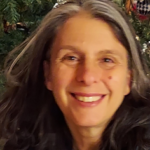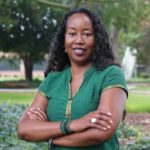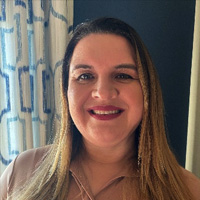Education First is proud to support a group of leading teacher preparation transformation centers (the Centers), technical assistance providers that support teacher preparation programs. The Centers, with the support of Education First, developed the DEI Companion Document to the Teacher Preparation Outcomes and Indicators, a guide to deepening a teacher preparation program’s focus on diversity, equity, inclusion and anti-racism (DEIA). In this three-part blog series, Centers meet with faculty and staff from their teacher preparation program partners to explore the programs’ existing and planned efforts to apply a deeper focus on DEIA, including efforts that are proposed in the DEI Companion Document.
In this first blog, Dr. Amy Murillo, the Continuous Improvement Coach at the Branch Alliance for Educator Diversity (BranchEd), meets with faculty at one of the Center’s program partners, Mount Saint Mary’s University Los Angeles. Throughout the blog, we will include snapshots that highlight how the program is engaging in some of the suggested actions that the DEI Companion Document presents. While every program is on its own unique DEIA journey, we hope this blog offers some learnings and inspires programs to continue the important work to transform teacher education.
Is your program interested in applying a deeper focus on diversity, equity, inclusion and anti-racism (DEIA) but doesn’t know where to start? You aren’t alone. DEIA work is crucial but challenging, and it often requires difficult conversations with staff, faculty and teacher candidates.
I recently spoke with Dr. Julie Feldman-Abe and Dr. Kimberly Nao from Mount Saint Mary’s University Los Angeles (MSMU) about their department of education’s ongoing efforts to apply an explicit focus on DEIA in their teacher education program. Their efforts seek to transform not only how they prepare candidates for the classroom but also how they, as teacher educators, enter their own classrooms.
Founded by the Sisters of Saint Joseph of Carondelet, MSMU is a Catholic university primarily for women that is dedicated to providing a superior education enhanced by an emphasis on building leadership skills and fostering a spirit to serve others. Dr. Julie Feldman-Abe is a faculty member at MSMU where she serves as the Director of the Elementary Teacher Preparation Program, the Center for Cultural Fluency and the Bridging Cultures: US and China program. Dr. Kimberly Nao is also a faculty member at MSMU where she serves as the Director of Induction and Instructional Leadership. She is also the Fritz B. Burns Endowed Chair of Education and an anti-racism consultant.

Dr. Julie Feldman-Abe

Dr. Kimberly Nao
AMY: I appreciate your willingness to speak with me today. Before we get to the specific activities your program is engaged in, I’d love for you to share with me a little bit about why diversity, equity, inclusion and anti-racism matter to you, both personally and professionally.
KIMBERLY: I have been dealing with the issue of race since pre-school. My mother is Japanese. My father was African American. I got many questions about race from very early on in my childhood. When I went to a predominantly White elementary school, I was treated differently because of my race. I had to grapple with why I was treated a particular way or why other children asked me certain questions. And so as I got older, I saw how race results in different life chances. It then became a focus of study for me in my college years and I became aware of the ways that race operates socially. All of these issues became increasingly important to me as I became a teacher and then a teacher educator because I want to make sure that those experiences that I had in school aren’t repeated for today’s children.
JULIE: My own lived experience is quite different from Kimberly’s. I grew up in New York as a Jewish woman in a predominantly White and Jewish suburb. My parents always tried to educate me about race. Even so, it was really in graduate school when I was working as a mentor and tutor in underserved schools in New York City that I started to understand how unfair and unjust the system was for those students. It’s one thing to understand something in theory but it’s another thing to build meaningful relationships with others who experience this injustice. Being raised as a Jewish woman, too, I was taught tikkun olam, repairing your corner of the world with whatever influence you have on it. That really resonated when I came to Mount Saint Mary’s, a Catholic University founded by the Sisters of St. Joseph of Carondelet. Our university is steeped in values of service and social justice.
AMY: Thank you both for sharing. And, Julie, that’s actually a great transition to my next question. From your perspective, why should teacher preparation programs prioritize DEIA?
JULIE: There’s a lack of consciousness about injustice, particularly among people who have not suffered from racism. We are so steeped in this idea that education creates equal opportunity for everyone in this country. But if teachers don’t consider inequities, we just reproduce them. Anti-racist emphasis in teacher preparation is important so teacher candidates understand how racism impacts schooling and see how they can be part of changing those systems and beliefs.
KIMBERLY: Often, we think that racism is a moral failing on the part of certain people, that it’s taught in the home and that we can’t really breach that so why bother trying to change people. Instead, let’s just change policies. But exposure to anti-racism and to the issues around anti-racism can shift teachers and it can shift attitudes and promote an understanding of the inequities that Julie talked about earlier. It’s important for teachers to understand this isn’t just about individuals behaving badly. What’s going on is steeped in and rooted in the history of this country. It goes toward changing the structures of schooling, and being aware of how to do that in ways that advance social justice, equity and anti-racism. That’s why I think it’s important for anti-racism to be embedded within teacher preparation programs.
“There’s a lack of consciousness about injustice, particularly among people that have not suffered from racism. We are so steeped in this idea that education creates equal opportunity for everyone in this country. But if teachers don’t consider inequities, we just reproduce them.”—Dr. Julie Feldman-Abe
AMY: I know that your program has taken steps to apply a deeper focus on diversity, equity, inclusion and anti-racism. Specifically, providing professional development to staff and faculty, engaging in discussions and beginning to implement assignments and coursework. Can you tell me what that looks like and how you brought faculty along for the journey?
JULIE: When we started talking about anti-racism and the need for anti-racist education in our teacher preparation program, it became clear that we didn’t all share the same understanding of what that meant. We all come from different lived experiences and different professional experiences. We felt it was important that we, as a faculty, learn from experts and engage in ongoing dialogue. This included discussions on questions such as: How do we know what anti-racist teaching looks like? How will we recognize it when we see it? Kimberly, do you want to share more about what we’re now doing?
KIMBERLY: Our work first started with a review of the curriculum to see where we already touch on anti-racism. We wanted to be thoughtful, strategic and collaborative about where and how we address anti-racism within the curriculum. And, as important, what our philosophy and ideology is as a department. To help us align, we chose a book to read together as a department. We chose Everyday Antiracism: Getting Real About Race in School by Mica Pollock. We set up an internal program to work our way through the book together and to have courageous conversations that would help us develop a clear understanding of what anti-racism meant to us as a department. Then, with our shared understanding, we revisited the curriculum together and reflected on how we could be intentional in developing an anti-racist curriculum.
AMY: Are there other aspects of the program that you’re similarly reflecting on as a department?
KIMBERLY: Beyond the curriculum, we started to think about what it would look like for a new faculty member to join an anti-racist department and participate in an anti-racist curriculum. What would that mean for us when we recruit and hire? What attitudes and dispositions would we look for? What pedagogical practice would we expect from them? There’s still so much more work to do but that’s where we are right now.
AMY: Wow, that sounds like amazing work. And I hear you when you say there’s still so much more to do. Is there anything else you’d want to highlight?
JULIE: We’re engaged in this project called Complexities in the Classroom with BranchEd. As part of that effort, I’m personally working with a diversity specialist at Los Angeles Unified School District, Dr. Judy Chiasson, and two Mount alumni to think about how to assess our teachers’ readiness for being able to handle challenging situations in the classroom related to various dimensions of identity. We then started to think about how we’d weave these assessments into the curriculum so that we can assess whether teachers grow in their competence, skills and confidence to address these challenges. We piloted the assessment with some of our faculty and are having ongoing dialogue with both faculty and candidates related to this.
Our next step is to do an all-call to faculty inviting them to revise their curriculum and classes with our new shared understanding of anti-racism. We’ll also want to then coordinate across faculty to ensure that there is coherence across the department and the curriculum.
AMY: What impact do you hope this work will have in both the short term and the long term for your faculty, candidates and the community that you and they serve?
KIMBERLY: I hope that we have teachers who understand and want to implement anti-racism in their classes and that we shift teacher learning. Over the years, I shifted the focus in my classes to include anti-racism. I had candidates emailing me in response to George Floyd’s murder to say thank you for shifting their teaching and that, as a result of our discussions in the classroom, they now had language to talk to their family and friends about the present-day impact and realities of systemic racism in America. Our courses can make a difference when they focus on these issues. I hope our teachers talk to their students and peers about these things differently. Hopefully some of these teachers will also become administrators and teacher leaders.
JULIE: My hope is that we’re contributing to our teacher candidates’ development in a way that sets them up to take the next step on their own. And that next step looks different for each candidate. Some enter our program and all of this is an introduction. For others, they’ve known this their whole lives and just need some more tools and an opportunity to share their ideas and resources with one another. I hope that with their growth in consciousness and anti-racist practice, they can positively impact the kids they work with.
“The big thing is using anti-racist courageous conversation protocols to have conversations within your own department and to come to a common understanding about what it means to focus on anti-racism in your teacher preparation programs.”—Dr. Kimberly Nao
AMY: There are others across the country that might read this and say, “I want to do that, too.” What advice would you give others who want to prioritize anti-racism in their teacher preparation program?
KIMBERLY: The big thing is using anti-racist courageous conversation protocols to have conversations within your own department and to come to a common understanding about what it means to focus on anti-racism in your teacher preparation programs. Relatedly, it’s important to draw on what people are already doing so that faculty and staff don’t feel like you are lecturing them. Then, you have to turn to your hiring practices so you hire people who are ready to take an anti-racist teaching approach.
AMY: Is there anything you would add, Julie?
JULIE: You need to meet people where they are. You can’t just say to people that this is our philosophy and this is what you now need to do. Instead, we need to create brave and safe spaces where everyone can find their own way into the material. To create brave and safe spaces, we also need to more deeply get to know one another so we don’t make incorrect assumptions. By challenging, affirming and inspiring one another, we can move forward in this work together.
AMY: Thank you both for that thoughtful advice. We’re coming to the end of our time together. Is there anything else you’d want to share that we haven’t already touched on?
KIMBERLY: We talked about the ways in which we backed up and slowed down, but I also want us to think about where we can go fast. For those of us who are marginalized, being told to go slow is frustrating. Finding those areas where you can go fast is important.
AMY: You’ve given me a great deal to think about. I, myself, have been in spaces where people wonder if we are ready to take on anti-racist work. But, like you both emphasized, ready or not, we need to move forward for the sake of our communities. And with that reminder, I thank you both for your time. You’ve truly inspired me, and I’m sure others will be similarly inspired, as well. Thank you!
| Resource Center
Below is a list of helpful resources, including those referenced above.
|
This post is the first in a three-part blog series authored by leading teacher preparation transformation centers—Branch Alliance for Educator Diversity, CalEPIC and CSU Center for Transformational Educator Preparation Programs (CSU CTEPP)—who are working together with other leading transformation Centers to transform the way teachers are prepared. In this series, leaders from these Centers talk with faculty and staff from their teacher preparation program partners about their existing and planned efforts to apply a deeper focus on diversity, equity, inclusion and anti-racism in teacher education. Read more about the three-part blog series here, and stay tuned for our upcoming blog posts. Don’t forget to share the series with your colleagues. We’ll be using #teacherprepmatters to spread the word, and invite you to do the same! Feel free to send comments to info@education-first.com and sign up for our email list.

